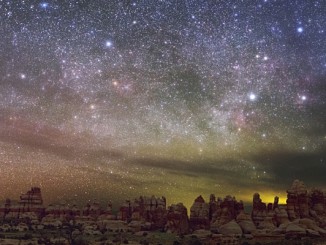
Acadia National Park will hold its annual Night Skies Festival 10—14 September this year.
According to the study, led by Robert Manning of the University of Vermont, 99 percent of the world’s skies suffer from light pollution and two-thirds of Americans can’t see the Milky Way from their homes.
Most light threatening the National Parks comes from development, the study says. Light from cities or towns can reach parks from as far away as 250 miles (400 kilometres).
“It’s a typical story,” Manning says. “We begin to value things as they disappear. Fortunately, darkness in a renewable resource and we can we can do things to restore it in the parks.”
Shedding light on the dark
In addition to gauging the value to park visitors of a dark nighttime sky, the study also provides data to park managers at Acadia — and by extension, other parks around the world — enabling them to develop visitor-driven plans for setting light pollution targets.
Mirroring a methodology Manning and his colleagues have used to understand other elements of the visitor experience, the researchers showed park visitors a series of photographs of nighttime skies at Acadia with successively more light pollution. The first photo had no pollution; each subsequent photo showed a three-fold increase in artificial light.
The larger amounts of light pollution were increasingly unacceptable to visitors, the study showed, with a threshold for an experience they no longer deemed enjoyable reached between the third and fifth photo in the sequence of eight.
With the help of specialists at the National Park Service’s Natural Sounds and Night Skies Division, managers at Acadia are able to correlate that threshold of acceptability with the amount of actual illumination in the park, which they can measure, and manage toward that objective.
Inside out
Reducing light pollution requires an effort targeted both inside and outside the park, said Manning. “Inside the park, you want to eliminate as much unnecessary light as possible,” he said. “Outside, the goal is to minimise light trespass. That’s more challenging, but possible.”
Steps that can be taken by visitors and parks to optimise night sky viewing include the following, according to Manning:
- Visitors should minimise light use, avoiding the use of headlights, flashlights and other sources of illumination as much as possible.
- Most light pollution derives from older style light sources that disperse illumination horizontally rather than directionally toward the target area. Converting to LEDs and other directional lighting will enable parks and neighbouring communities to dramatically reduce light pollution in the parks.
- The growing popularity of astronomical tourism provides a financial incentive for towns and cities neighboring parks to reduce light pollution and should be encouraged.
Two parks have been especially successful in reducing light pollution, the study says: Acadia, which worked with the neighbouring city of Bar Harbor to implement a progressive lighting ordinance, and Chaco Culture National Historical Park in New Mexico, which partnered with stakeholder groups to successfully encourage the state legislature to pass the New Mexico Night Sky Protection Act.

